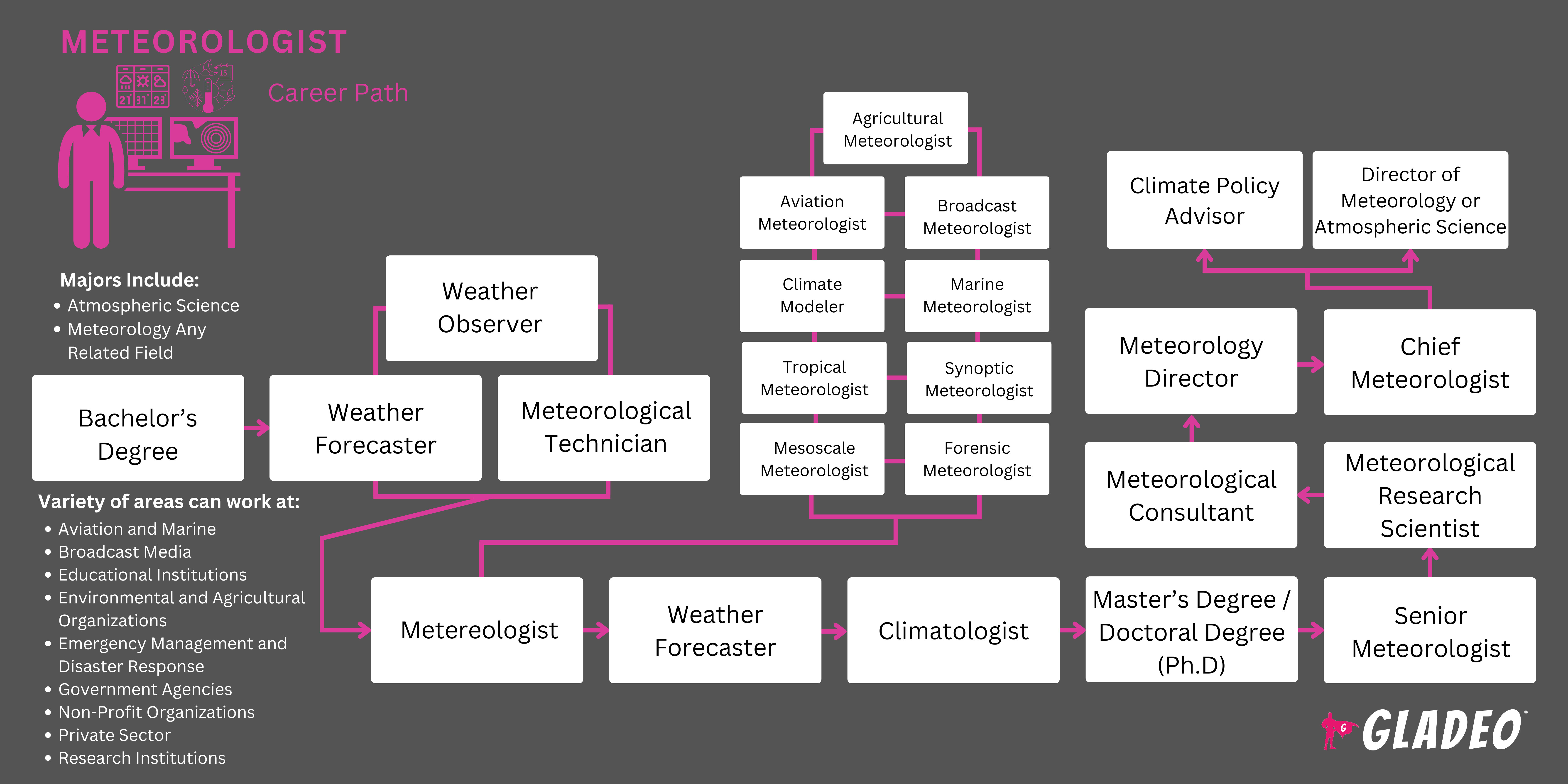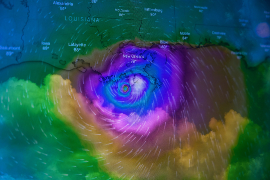Spotlights
Broadcast Meteorologist, Forecaster, Forensic Meteorologist, General Forecaster, Hydrometeorological Technician, Meteorologist, Research Meteorologist, Space Weather Forecaster, Warning Coordination Meteorologist, Weather Forecaster, Atmospheric Scientist
If you’ve ever checked the weather before heading out—or watched a storm roll in on the news—you’ve seen the work of Meteorologists in action!
Meteorologists are scientists who study the atmosphere to understand and predict weather patterns, climate trends, and severe storms. Using data from satellites, radar systems, and weather stations, they analyze temperature, air pressure, wind, and humidity to forecast short-term and long-term weather conditions.
Some Meteorologists work in broadcasting, delivering daily forecasts to the public through TV, radio, or online platforms. Others work behind the scenes in research, aviation, environmental agencies, or the military, providing critical weather data that helps protect lives, guide flights, or plan agricultural and emergency operations.
Meteorologists also play a key role in studying climate change, analyzing long-term shifts in weather patterns to help governments and industries adapt to a changing world. Their work combines science, technology, and communication—all to help people make better, safer decisions every day.
- Helping communities stay safe during severe weather events.
- Working with cutting-edge technology and data systems.
- Being part of real-time decision-making for emergency response and aviation safety.
- Seeing your forecasts influence public awareness and action.
- Contributing to climate and environmental research that shapes the future.
Working Schedule
Meteorologists often work full-time, and those in broadcasting or aviation may work irregular hours, including nights, weekends, or holidays to cover major weather events. Research meteorologists typically have more standard lab or office schedules, while field scientists may travel to collect data or study storms firsthand.
Typical Duties
- Collect and analyze atmospheric data from satellites, radar, and weather stations.
- Use mathematical models and computer simulations to predict future weather conditions.
- Prepare and communicate weather reports to the public or specific industries.
- Issue warnings for severe weather such as hurricanes, floods, or heatwaves.
- Research long-term climate trends and environmental changes.
- Maintain weather instruments and ensure data accuracy.
- Collaborate with scientists, engineers, and emergency planners.
Additional Responsibilities
- Specialize in areas such as aviation, marine, broadcast, or climate meteorology.
- Train junior staff or interns on forecasting techniques.
- Contribute to scientific research and publish studies.
- Present findings at conferences or in academic journals.
- Work with environmental agencies to plan for climate adaptation.
A meteorologist’s day begins early—often by reviewing data from satellites and weather stations around the world. They analyze maps, computer models, and radar images to spot patterns and prepare forecasts.
Those in broadcasting spend time scripting and recording weather segments, while others issue official weather warnings or brief pilots on flight conditions. During severe weather, meteorologists may work long hours monitoring real-time developments and updating alerts.
Researchers might spend their day coding models, analyzing long-term data, or studying atmospheric chemistry. Every day brings new challenges, from predicting afternoon thunderstorms to studying global climate shifts.
Soft Skills
- Analytical and critical thinking
- Problem-solving and curiosity
- Clear communication (especially under pressure)
- Attention to detail
- Teamwork and collaboration
- Adaptability to fast-changing data
- Dedication and public service mindset
Technical Skills
- Knowledge of meteorological and climate modeling software
- Data analysis and statistical programming (Python, R, MATLAB)
- Radar and satellite interpretation
- Geographic Information Systems (GIS)
- Weather observation equipment operation
- Strong math and physics background
- Computer programming and simulation modeling
- Broadcast Meteorologist – Delivers daily weather forecasts to the public on TV, radio, or online.
- Operational Meteorologist – Provides forecasts and alerts for industries such as aviation, military, or energy.
- Climatologist – Studies long-term atmospheric trends and climate change impacts.
- Research Meteorologist – Conducts experiments and develops models to improve forecasting accuracy.
- Hydrometeorologist – Focuses on rainfall, floods, and water cycle impacts.
- Forensic Meteorologist – Analyzes past weather events for legal or insurance cases.
- Environmental Meteorologist – Examines air pollution, atmospheric chemistry, and human impacts on weather.
- Government agencies (NOAA, NASA, or National Weather Service)
- TV and radio broadcasting networks
- Research institutions and universities
- Military and defense organizations
- Aviation and aerospace companies
- Environmental and consulting firms
- Energy, agriculture, and transportation industries
Meteorology can be unpredictable—literally! Long, irregular hours and high-pressure deadlines are common, especially during severe storms or disasters. Forecasting errors can have serious consequences, so the work demands precision, focus, and accountability.
Field meteorologists may face extreme conditions when collecting data. Broadcast meteorologists must perform live on camera, sometimes covering dangerous weather events.
Still, for those who love science, nature, and helping others, few jobs are as exciting—or as impactful—as predicting the weather.
“For me, forecasting isn’t just about predicting the weather—it’s about saving lives and helping people make better decisions.” — Dr. Jenni Evans, Professor of Meteorology, Penn State University
Meteorology is becoming increasingly data-driven. Artificial intelligence, machine learning, and supercomputing now play major roles in improving forecast accuracy.
Climate change research is expanding career opportunities in environmental policy, sustainability, and risk management. Demand for meteorologists is also growing in renewable energy sectors, aviation safety, and insurance analytics.
Remote sensing technology and drones are changing how atmospheric data is collected, while social media allows forecasters to reach audiences instantly.
People in this career often enjoy watching thunderstorms, tracking typhoons, or reading about space and nature. They were curious about why the sky changes color, how clouds form, or what causes lightning. Many loved science fairs, math challenges, or using weather apps to track storms. They probably had a scientific mindset, loved solving puzzles, and enjoyed explaining things to others—all skills that make great meteorologists.
Most Meteorologists hold at least a bachelor’s degree in Meteorology, Atmospheric Science, or a closely related field such as Environmental Science or Climatology.
Advanced research or teaching roles may require a master’s or doctoral degree, especially for work in climate modeling or atmospheric research.
Common course topics include:
- Atmospheric Dynamics and Thermodynamics
- Climatology and Climate Change
- Physics and Calculus
- Meteorological Instrumentation
- Remote Sensing and Satellite Meteorology
- Synoptic Meteorology
- Computer Modeling and Data Analysis
- Environmental Science and Hydrology
- Communication for Scientists
Additional specialized training and certifications may include:
- Remote Sensing and Satellite Meteorology Certification
- Radar Operations and Data Interpretation Training
- Numerical Weather Prediction (NWP) and Climate Modeling Courses
- Geographic Information Systems (GIS) Certification
- Advanced Climate Data Analysis Workshops
Continuing Education Units (CEUs) from professional organizations like the American Meteorological Society (AMS) to maintain credentials and stay updated with new technologies
- In high school, focus on math, physics, computer science, and earth science courses.
- Join science clubs or weather-related student groups.
- Watch weather reports and learn how forecasts are made.
- Try short online courses in meteorology or climate science on Coursera or edX.
- In college, seek programs accredited by the American Meteorological Society (AMS).
- Participate in internships with weather stations, environmental agencies, or TV networks.
- Get hands-on experience using forecasting tools or atmospheric data software.
- Attend weather conferences or AMS student chapters to network with professionals.
- Keep a portfolio of research projects, data visualizations, or weather reports you’ve created.
- Ask professors or supervisors to serve as references for internships or grad school.
Choose programs that offer hands-on experience with forecasting labs, weather stations, or internships.
Programs that combine data science, environmental studies, and communication skills will prepare you for diverse career options.
Top schools and programs include:
- Penn State University – Department of Meteorology and Atmospheric Science
- University of Oklahoma – School of Meteorology
- Colorado State University – Atmospheric Science Program
- University of Reading (UK) – Meteorology Department
- University of the Philippines – Institute of Environmental Science and Meteorology

- Search for openings on sites like NOAA Careers, USAJobs.gov, Indeed, LinkedIn, and Glassdoor using keywords such as meteorologist intern, weather forecaster trainee, climate data analyst, or atmospheric technician.
- Apply for entry-level positions that let you gain hands-on experience analyzing data, writing forecasts, or supporting field operations—roles like weather observer, forecast assistant, or climate technician. These jobs can lead directly into full meteorologist or research scientist roles.
- Don’t just focus on national weather agencies—look at private forecasting companies, TV stations, aviation services, and energy firms, which also hire meteorologists.
- Target employers that provide on-the-job training or mentorship, such as the National Weather Service (NWS), NASA, AccuWeather, or environmental consulting firms.
- Highlight coursework or experience with computer modeling, data visualization, GIS, or climate research on your resume, along with any internships or fieldwork.
- Join professional groups like the American Meteorological Society (AMS) or the National Weather Association (NWA) to build your network, attend conferences, and learn about job openings.
- Ask professors, research mentors, or internship supervisors to serve as references, especially if they can speak to your technical and analytical skills.
- Stay updated on the latest forecasting tools and climate research, and be prepared to explain how you interpret weather data or communicate forecasts clearly during interviews.
- Finally, dress professionally for interviews and show your enthusiasm for science, problem-solving, and helping people stay safe and informed.
- Earn advanced degrees (M.S. or Ph.D.) in Meteorology, Atmospheric Science, or Climate Science to qualify for research or senior forecasting roles.
- Obtain professional certification from the American Meteorological Society (AMS), such as the Certified Broadcast Meteorologist (CBM) or Certified Consulting Meteorologist (CCM) credentials.
- Specialize in a niche field such as aviation meteorology, severe weather analysis, climate risk assessment, or ocean-atmosphere interaction.
- Publish your findings in peer-reviewed journals, contribute to weather research papers, or present at professional conferences.
- Take on leadership or supervisory roles within weather services, government agencies, or research institutions.
- Improve your communication, presentation, and public speaking skills—especially if you aim for a career in broadcasting or public outreach.
- Stay current with new forecasting models, data visualization software, and climate modeling tools.
- Get experience with international or interagency collaborations, such as working on global climate initiatives or environmental monitoring projects.
- Mentor junior meteorologists or participate in professional organizations like the AMS or National Weather Association (NWA).
- Consider teaching at the college level or becoming a research program director to shape the next generation of meteorologists.
Websites
- American Meteorological Society (AMS.org)
- National Weather Service (weather.gov)
- NOAA – National Oceanic and Atmospheric Administration (NOAA.gov)
- Climate.gov
- The Weather Channel Careers
- O*NET OnLine
- CareerOneStop.org
- NASA Earth Science Careers
- National Centers for Environmental Information (NCEI.noaa.gov)
- National Weather Association (nwas.org)
- AccuWeather Careers
- Earth Science Careers at USAJobs.gov
Books
- Weather: A Very Short Introduction by Storm Dunlop
- Meteorology Today by C. Donald Ahrens
- The Thinking Person’s Guide to Climate Change by Robert Henson
- Extreme Weather by Christopher C. Burt
- The AMS Weather Book by Jack Williams
Meteorology and atmospheric science are rapidly changing due to technological innovation and climate challenges. There will still be strong demand for weather experts, but many will shift toward climate data analysis, environmental consulting, or renewable energy forecasting as new tools and AI reshape the field.
Curious about some similar career options with related skill sets? Then check out the list below!
- Environmental Scientist
- Climate Change Analyst
- GIS Analyst
- Data Scientist
- Hydrologist
- Air Quality Specialist
- Science Communicator or TV Reporter
- Renewable Energy Analyst
Click here to download the infographic
Newsfeed

Featured Jobs

Online Courses and Tools







